Cooking Fires
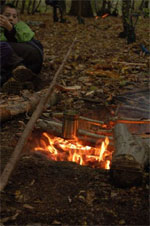
Downloadable Guide
One of the main reasons for building a fire is to provide a basis for cooking food and heating water.
There are many techniques available and some are more suitable then others. It all depends on the materials to hand, the food and method of cooking and the time available to build and cook the food.
Trench Fire
Perhaps one of the simplest possible fires, the name suggests it all. Dig yourself a trench around 1m by 30cm (3 x 1 ft) and around 30 cm deep (1 ft). Place a layer of rocks on the bottom of the trench. Now build your fire on top of the rocks.
By placing the rocks on the bottom, they will absorb and hold a lot of the heat. Even once the fire has died down the rocks can be used as a 'grill'.
For general cooking you can use the pot rod holders in the camp gadget section, or a simple wire mesh across the trench with all your items on top, or even a spit placed across the trench.
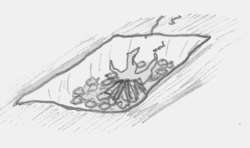
Yukon Stove
This takes a very large effort to build, but once built it can burn almost anything.
Dig a circular hole around 24cm (9 inches) deep with a channel on one side leading down to it. Place rocks all round the outer edge of the hole and build them up into a funnel shape, gradually sloping inwards. Remember to 'bridge' over the channel you made. Towards the top of the funnel make the rocks 'open out' again.
Now seal all the rocks with earth. You now effectively having a sealed, insulated chimney creating a good draught to maintain the fire.
To start it working, light your fire in the channel so that you can see what you are doing. When the fire has caught and is going well push it down the channel beneath the chimney. To contain to fuel the fire, drop the wood in through the top of the chimney.
You can control the rate at which the fire burns by opening or closing the top. This fire will leave little ash and will burn for a long time before it needs clearing out.
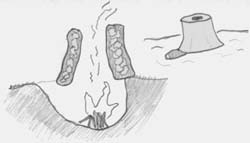
Hangi Method
I have not tried this one myself. Apparently it is a way of cooking without utensils by heating stones.
Dig an oval shaped hole with rounded sides around half a metre deep (20 inches) and place kindling at the bottom. You then lay logs across the hole, then another layer of logs that lay at right angles to the previous layer. You intersperse the logs with stones around fist- size. Continue to build up layers this way until you have around 5 or 6 layers, topping off with stones on the very top.
When you set the kindling alight, the logs will burn heating the stones above them, until eventually they all fall down into the pit. Then you remove the embers and ash
Next you place your food on top of the hot rocks (meat in the centre, vegetables towards the edge). There must be gap between the food and the earth.
Now lay saplings across the pit and place leaves etc on top of them, covering the lot with earth. This will keep the heat in and act like a pressue cooker.
After one and a half hours remove the cover and you will find your meal cooked to a treat.
Sounds like a good thing to try at the next scout camp!
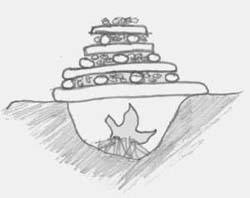
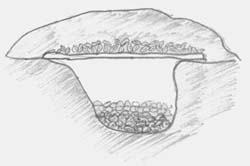
Metal Box Oven
A very common contraption, I'm sure most of you have heard/seen/ tried this one before. A large food tin or metal box makes an excellent oven (preferably with some sort of hinged lid). The door can open sideways, or even downwards to rest upon a pile of rocks to make a shelf to bring your food out onto.
Even without a metal box you could try to make a clay dome.
Basically all you have to do is stand the box on some rocks (so that you can light a fire beneath it to heat the oven). The trick is to build up insulation around the oven by covering all round with earth and rocks. Be sure to leave a small gap at the back of the oven to let the heat and smoke from the fire move around. Similarly you will need to push a small hole for a chimney at the top of the back part. Once finished you have an oven that can be used much like the one in your home.
Boiling
I think its clear that you will need a container to cook in boiling water. Pots and cans are ideal and you can use the gadgets to help make dealing with them easier.
However if you want to cook without these (backwards man style) then the only two containers that I know to be of use are the birch bark ones (again in the gadgets section) and a length of bamboo.
To cook in bamboo, find yourself a stem and angle it across the fire by supporting one end with a forked stick. Water can be poured down the end and will eventually boil.
If you have no containers at all you can use the Hangi method and simply place the water in the pit. Make sure the pit is well 'sealed' unless you just want the water to drain away!
Roasting
The easiest method to roast meat is to skewer it on a spit, and place it across the fire by supporting either end with forked sticks driven into the ground. The fat itself will help cook the meat so be sure to turn the meat occasionally to get the fat running over the surface.
You must be careful to roast the meat slowly. A quick fierce fire will simply roast the outside, sealing the meat meaning the inside will be very undercooked (and hence dangerous to eat). Or at the very least, cut off the outer flesh to eat and let the inner flesh carry on cooking.
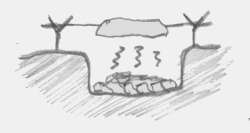
Steaming
Steaming is an excellent way of cooking fish and green vegetables. You need to suspend the food in the steam from boiling water.
The simplest way to do this is to make holes in a can and then suspend it within a larger can (or resting it on some stones placed in the bottom of the larger can). Cover the outer can so that no steam is lost, but do not completely seal it or the pressue will build up and it will explode!
For the backwoods-man style steamer, find yourself a suitable bamboo length that has several 'sections'. Make a small hole between the sections of the bamboo (this is the most tricky part to do!) making sure the hole is big enough to let water flow through to the bottom. As before rest the bamboo across the fire by propping with a forked stick. Pour the water down so that it fills the lower section, and place your food in the top section. Make a (loose) lid for the top and the steam produced will cook your food.
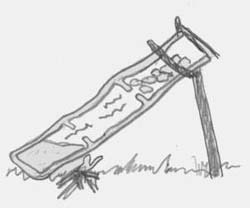
Hobo Stove
To make this you will need an oil drum of some description (5 gallons would be sensible for a small fire). Simply make holes at the bottom of the drum and the sides, and cut your self a 'door' towards the base end. Leave the top of the drum sealed for cooking (you may want to make a few holes on one side at the top to let the smoke out).
Start the fire inside the drum and stoke it through the door. If the drum is placed on a ring of stones or similar the draught underneath the drum will keep the fire burning well. Cooking can take place upon the top of the stove (and it will keep you warm too, just what the 'Hobos' use it for).
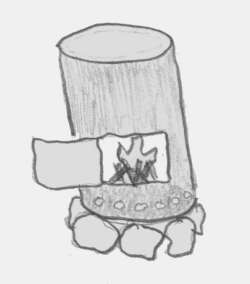
Baking
Baking will need an oven of some description. There are many different types but they are all largely similar in design. Baking is suitable for tough meat and for root vegetables. You can use an oven to cook most of your meal at once.
Frying
Again we mostly use some container (metal) to fry within. It is possible however (although I can't say I have tried it!) to fry certain foods by placing them on a large leaf which contains some oil. Apparently banana leaves are ideal to fry eggs on, although not exactly common in this country.
Grilling
Grilling is a nice simple way of cooking. It requires a support of some kind, normally a wire mesh rested on logs/stones across the fire.
However, any rocks that have been heated by the fire can be used as grilling surfaces, or you could skewer your food and rest it across the fire.
For the backwoods style, make yourself a mesh from very green sticks weaved in-and-out around themselves (aim for a 'tennis racket' type shape by using a strong forked green stick as the frame). You can place your food on the mesh, or you could even include the food within the mesh. A good example is to place a piece of fish within the mesh and weave around it.